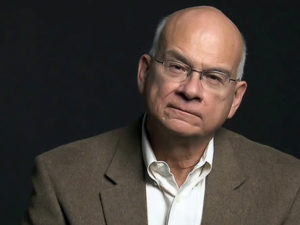When more than 200,000 evangelical purity pledges were being planted at the National Mall in 1994 at the height of the True Love Waits movement, nobody would have imagined that the next 25 years would bring about a total revolution in how Americans viewed same-sex marriage.
While at the time — now 25 years ago — just 27% of Americans supported same-sex marriage, today that number has steadily risen to 70%.
In 1994, evangelicals perceived the greatest threat to sexual purity as teenage promiscuity and male-female sex outside of marriage. But another sexual revolution was under way that would soon take center stage in the evangelical list of concerns.
Pollsters report that the shift in American attitudes on same-sex marriage are one of the most rapid and consequential shifts on a social issue they’ve ever seen. And that shift has left evangelical leaders sounding a new alarm.

Albert Mohler
When the Equality Act passed the House of Representatives earlier this year, conservative evangelical leader Al Mohler called it “a draconian threat” of a “new moral regime.”
What was happening in Washington now — not on the National Mall but inside the Capitol — was sure to elicit a strong evangelical Christian response. That was ensured by the fact that leaders of the Anglican Church in North America, the Southern Baptist Convention and the Presbyterian Church in America all would hold meetings this year. And at all three, same-sex marriage fell near the top of the agenda.
As statements and resolutions from the three denominations were released, key commonalities and distinctions began to appear.
In the beginning
All three denominations begin their opposition to same-sex marriage by basing it on the creation stories of Genesis 1 and 2.
All three denominations begin their opposition to same-sex marriage by basing it on the creation stories of Genesis 1 and 2.
The Anglican Church’s College of Bishops said in an official statement on sexuality and identity: “Our foundation is the scriptural truth that God made us male and female in his image — a profound unity with distinction (Genesis 1:27). God established marriage between male and female to fill the earth through procreation (Genesis 1:28).”
At the SBC annual meeting, messengers passed a resolution against the Equality Act that begins: “Whereas, all persons are created in God’s image (Genesis 1:27), are made to glorify him (Isaiah 43:7), and, based upon these truths, possess inherent dignity; and whereas, God’s design was the creation of two distinct sexes, male and female (Genesis 1:27; Matthew 19:4), which designate the fundamental distinction that God has embedded in the very biology of the human race; and whereas, the Bible gives us clear instruction and boundaries with regard to what constitutes God-honoring expression of human sexuality (Genesis 2:24) … .”

Tim Keller
The PCA’s 48th General Assembly released a report on sexuality that was written by a committee made up of seven men, including Bryan Chappell, Kevin DeYoung, Tim Keller and others. The report said: “We affirm that marriage is to be between one man and one woman (Genesis 2:18-25). … We affirm that God created human beings in his image as male and female (Genesis 1:26-27).” In a formal document known as Overture 16, they said: “God created Adam and Eve and ordained the first marriage and family consisting of one man and one woman in sexual union, establishing the context for the biblical sexual ethic (Genesis 1:27-28; 2:24; 4:1).”
The theological foundation for each of these three denominations regarding their opposition to same-sex marriage is based on their belief that Genesis 1 and 2 teaches that monogamous, heterosexual marriage was designed by God at creation in Adam and Eve, with the SBC claiming that this design is biologically embedded in the human body.
Falling in lust?
Just as all three begin with a view of creation, each blames the existence of same-sex attraction on the Fall.
The Anglicans explained: “We say, with Augustine, that this Fall has affected our lives in destructive ways that have disordered our affections … same-sex attraction is one manifest type of disordered affection.”
The SBC echoed with, “Southern Baptists resolved in 2014 ‘On Transgender Identity’ that, ‘The Fall of man into sin and God’s subsequent curse have introduced brokenness and futility into God’s good creation,’ and therefore, as a result some are tempted to question God’s gift of sexuality.”
Likewise, the PCA said: “We affirm that from the sin of our first parents we have received an inherited guilt and an inherited depravity (Romans 5:12-19; Ephesians 2:1-3). From this original corruption — which is itself sinful and for which we are culpable — proceed all actual transgressions. All the outworkings of our corrupted nature (a corruption which remains, in part, even after regeneration) are truly and properly called sin. Every sin, original and actual, deserves death and renders us liable to the wrath of God.” They added: “All of us who are descended from Adam and Eve experience their corrupted nature and the complex of disordered affections, desires and attractions that come with that corruption.”
All three denominations declared that anything other than heterosexual attraction came into existence through the Fall … and is, therefore, inherently sinful.
All three denominations declared that anything other than heterosexual attraction came into existence through the Fall after the creation of Adam and Eve and is, therefore, inherently sinful.
Dealing with the fallout
The question for these three denominations then becomes what to do with Christians who claim to follow Jesus while experiencing any sexual desires other than heterosexual desires.
The Anglicans acknowledged the abuse LGBTQ Christians have faced and offered their love, respect and encouragement. Then they affirmed that “same-sex sexual practice” is incompatible with Scripture and church tradition. They explained their pastoral and theological reasoning for rejecting the term “gay Christian” and even “same-sex attraction,” and recommended instead using “Christians who experience same-sex attraction.”
In contrast to this more pastoral focus, the SBC immediately shifted into politics. Their resolution discussed the Equality Act, the Civil Rights Act of 1964, the First Amendment, and the opinions of congressmen Chuck Schumer and Ted Kennedy during adoption of the Religious Freedom Restoration Act of 1993. Then they said that the Equality Act would “bring sweeping and historic changes to religious liberty with devastating effects to this foundational freedom,” while specifically warning that faith-based charities would have to “choose between freely exercising those core religious beliefs or abandoning their ministries.”
The SBC claimed the government is punishing “faith-based charities for serving the common good,” and that the government would punish individuals as well. Then they warned that the government would “coerce health care providers to participate in and provide abortions, hormone therapies, and other procedures,” that it would undermine bipartisanship, and that it would threaten the civil rights of women and girls to compete in sports while having private sleeping quarters and restrooms.
The SBC said its members should “extend love and compassion” to the LGBTQ community while calling them to repent of their sin and to oppose the Equality Act.
In the end, the SBC said its members should “extend love and compassion” to the LGBTQ community while calling them to repent of their sin and to oppose the Equality Act while “joyfully celebrating God’s good design of males and females and heterosexuality as clearly expressed in Scripture.”
Rather than focusing on pastoral or political concerns, the PCA concentrated on an exegetical explanation of how their theologies of marriage, the image of God, original sin, desire, concupiscence, temptation, sanctification, impeccability, identity, language, friendship, repentance and hope lead them to oppose same-sex marriage. But then they went a step further than even the Anglicans or the Southern Baptists by saying that “men who identify as homosexual, even those who identify as homosexual and claim to practice celibacy in that self-identification, are disqualified from holding office in the Presbyterian Church in America.”
PCA official Chris Norris said, “Sanctification begins with one’s identity as a new creation in Christ. … Taking a gay identity flies in the face of the new creation.”
According to all three denominations, anyone who identifies as Christian and gay was actually created for heterosexuality, is experiencing a desire that didn’t exist until after Adam and Eve fell, and must refrain from engaging their sexuality in any way other than in heterosexual, monogamous marriage.
While there may be unique emphases or differences regarding pastoral care, politics or pastoral qualifications, the common thread that binds together these three denominations is their view of all human sexuality being theologically and biologically tied to the creation and fall of Adam and Eve.
A new creation
Because these denominations propose that the traces of God’s original design and sexual brokenness from Adam and Eve’s fall have been “embedded in the very biology of the human race,” we have permission to examine whether biology confirms their hypothesis.
If sex was God’s gift to Adam and Eve after bringing them together in a heterosexual monogamous marriage, if other forms of sexual relationship came into existence after Adam and Eve’s fall, and if all humanity descended from Adam and Eve, then the theology and sexual requirements of the Anglicans, the SBC and the PCA might hold up.
The problem, of course, is that this conservative evangelical story of creation, the fall and human sexuality is biologically untenable. And it relies upon a belief in young-earth creationism that denies key findings in science and world history.
Initially, reproduction happened asexually as cells divided to form more cells. Thus, the original creation did not have two distinct genders as described in Genesis 1.
The original creation did not have two distinct genders as described in Genesis 1.
While the universe is estimated to be 13.8 billion years old and the earth to be 4.5 billion years old, sexual reproduction and the emergence of male and female sexes within a species began to evolve approximately 1.2 billion years ago. Modern humans evolved over just the past 200,000 years. Thus, sexuality was not a static gift to humanity after the creation of Adam and Eve for procreation, pleasure, purity and as a picture of the kingdom of God. Instead, humanity is one recent species that grew out of the broader story of ancient evolving sexuality in the cosmos.
Cosmic sexuality
Because the actual story of sexuality and humanity is so different than the one described in Genesis 1 and 2, many Christians are beginning to wonder how they can restrict their LGBTQ family and friends from engaging their sexuality based on a creation story they believe should not be read literally.
What could a theology of sexuality look like in light of the universe’s broader creation story?

Ilia Delio
In her book The Unbearable Wholeness of Being, Franciscan theologian and scientist Ilia Delio offers one such possible vision, saying: “The discovery of evolution, according to Teilhard de Chardin, is not only a new scientific discovery of nature but of nature passionately alive, throbbing, and pulsating with energy and growth.”
Delio proposes that when we begin to see how the cosmos brings about spontaneous relationships of individuals being drawn into community, even down in the quantum world of particles bonding to transcend as atoms, we will see what Teilhard meant when he said that “being is relational.”
Even at the level of molecules, Teilhard said, “love was the building power that worked against entropy, and under its attraction the elements groped their way towards union.”
As a result, Delio says that “the cosmos is oriented toward integral wholeness, complexification and consciousness.”
The assumption in sexuality, then, is that “we are a part of a whole and have been separated from the whole.” For Teilhard, sexuality leads humans “one through the other, to a higher possession of their being.” Or as Delio puts it: “Love attains a higher consciousness through a deeper centeredness or union of souls. Authentic sexual love (without control or manipulation) is the emergence of spirit.”
Therefore, sexuality in light of our true cosmic and evolutionary story goes far beyond simply who you desire to experience an orgasm with.
Delio affirms that, “Sex is not mere continuation of the species; it is the energy of love by which this universe is in the process of personalization, becoming more spiritualized, energized and conscious.”
The complex depth of the sexual desires we have are not the result of the fall of two people but were grown in our bodies for billions of years as evolution brings about greater complexity, depth and union.
She concludes that “Love, sex, and cosmic evolution are intertwined in a field of integral wholeness; to deny, avoid, or negate any of them is to thwart the process of deepening life … . If wholeness is at the heart of life, then behavior itself will ultimately depend on love if a species is to survive … . Love is creative because the nature of wholeness is open and dynamic. Love is not a mechanistic force or lawful determinant but rather a creative power that unites. It is not a measurable particle but life-giving energy. Love draws together even in the face of resistance. If energy is the fire of life, then love is the energy of all life. Evolution rests on the power of love because what ignites the core of being is ultimately unitive and transformative.”
A sexuality of wholeness
According to this view, every particle in our bones, blood and flesh has been gravitating toward union with another for billions of years. The complex depth of the sexual desires we have are not the result of the fall of two people but were grown in our bodies for billions of years as evolution brings about greater complexity, depth and union.
That reality is a fundamentally different story of cosmic and biological sexuality than what the Anglicans, the Southern Baptists or the conservative Presbyterians are describing.
Rick Pidcock currently serves as a Clemons Fellow with BNG. He recently completed a master of arts degree in worship from Northern Seminary. He is a stay-at-home father of five kids and produces music under the artist name Provoke Wonder.
Related articles:
Equality Act stirs passions about the definition of religious liberty and RFRA’s role
Baptist advocates for Equality Act say they are motivated by love of freedom as a faith virtue


